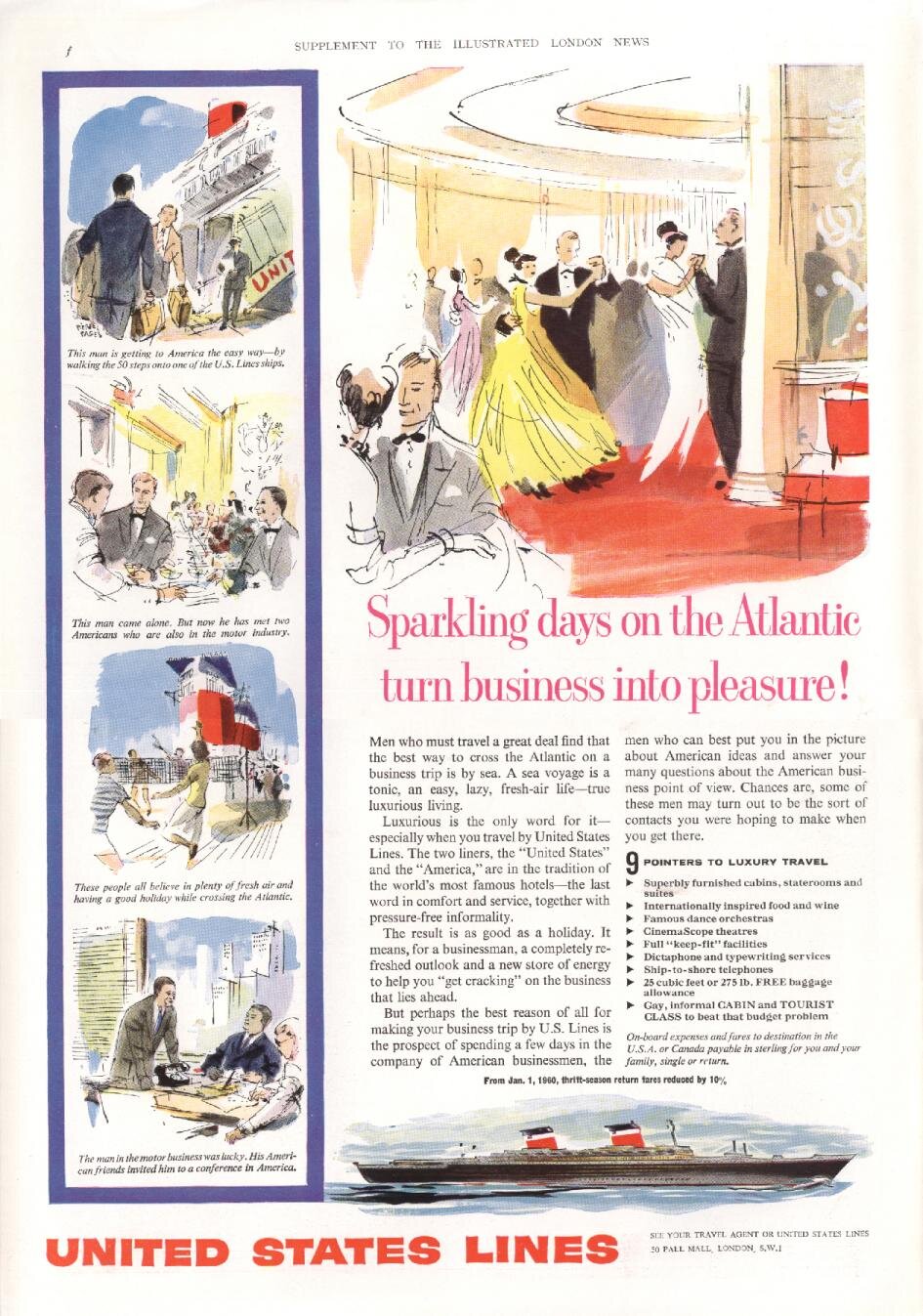ADVERTISING THE UNITED STATES:
DISCOVERING AMERICA’S FLAGSHIP THROUGH PRINTS, POSTERS, AND ADVERTISEMENTS
Home | Advertising the United States | United States as Stage | Sailing in the Age of the Jet | Shop
PREVIOUS: Introduction | NEXT: The United States as Stage
Advertising the United States
The ad age
The medium of advertising crosses boundaries of gender, race, age, and class, even if the products they market do not. These images and catchy phrases can be found nearly everywhere, from magazines and newspapers to the television screen and even along highways. Their reception, however, depends greatly on what is being advertised and to whom.
The 1950s and 1960s brought a fundamental change to the world of advertising. Not only did innovations in television and printing technology make ads ubiquitous; those ads were also more powerful than before. For the first time, advertisers harnessed the power of market research and behavioral science to create messages psychologically tailored for specific audiences, forever changing the way consumers interacted with products. A person reading Vogue magazine, for example, would encounter intentionally placed advertisements designed to appeal to Vogue readers, those interested in high fashion and luxury items. Catchy, amusing, and visually appealing, these ads did more than just sell products: they were reflections of the society in which they were created, carrying, and even cultivating, cultural values. The advertisements that feature the SS United States are paragons of Ad Age design. They are a window into the liner’s social and political role in the post-War world.
Tourism and a new economy
Advertisements played a major role in efforts to revitalize the world economy after World War II. After years of wartime rationing, restrictions on travel, and a national campaign encouraging those at home to save, many Americans were eager to spend, especially abroad. Tourism and the idea of the ‘Vacation’ were not new to the post-War world, but were certainly improved. With new technologies available to make traveling more comfortable and a belief that traveling would spread capital around a recently war-torn world, vacations were framed as not just a luxury, but a necessity for those who had the money to spend. The government encouraged this idea, knowing that tourist dollars spent overseas would aid international economic recovery and solidify America’s status as a financial, political, and cultural leader of the post-War world.
Advertisements led the effort to convince Americans of their ‘patriotic duty’ to travel. Ads featuring the SS United States in particular showed potential passengers that travel was more accessible and enjoyable than ever before. By framing the trip to Europe as nothing more than a “long weekend,” or a “vacation - before your vacation” advertisements offered the public a narrative surrounding tourism that was hard to resist. With the widespread implementation of paid leave, more Americans, from all walks of life, were able to take vacations than ever. The SS United States, like her predecessors, offered multiple classes of travel, with rates at lower prices, which made room for the economic traveler or immigrant. Through these advertisements of the United States, we are able to piece together a story of post-War America and the reconstruction of the “American Dream.”
Traveling aBoard the American Dream
The 1950’s also saw a world working to recover from the devastation of war. Many Americans did not know what the aftermath of World War II would bring, both at home and internationally. While the economies of countries abroad suffered greatly, the United States saw an economic upturn. In fact, more Americans were considered part of the middle class than ever before, a sentiment which was reflected in their consumer behavior.
After years of wartime rationing, restrictions on travel, and a national campaign that persuaded those at home to save and sacrifice, many Americans were eager to spend. Advertisements played a major role in encouraging the American consumer to buy “more, newer, and better,” hoping that with their newfound spending power, Americans would be able to stimulate the economy not just on the homefront, but internationally as well. The government encouraged this idea, knowing that tourist dollars spent overseas would aid international economic recovery while further cementing America’s status as a financial, political, and cultural leader of the postwar world.
Tourism and the idea of the vacation were not new to the postwar world, but they were certainly improved. With new technologies available to make traveling more comfortable and the belief that traveling would spread capital around a recently war-torn world, vacations were framed as not just a luxury, but a necessity for those who had the money to spend. Advertisements led the effort to convince Americans of their ‘patriotic duty’ to travel. Ads featuring the SS United States in particular showed potential passengers that travel was more accessible and enjoyable than ever before. By framing the trip to Europe as nothing more than a “long weekend,” or a “5 day house party” advertisements offered the public a narrative surrounding tourism that was hard to resist. With the expansion of the middle class and the widespread implementation of paid leave, more Americans than ever, from all walks of life, were able to take vacations. The SS United States, like her predecessors, offered multiple classes of travel, which made room for the budget traveler or immigrant, while also catering to this postwar national push to spend. Through these advertisements of the SS United States, we are able to piece together a story of post-war America, the nation’s economic growth and development, and the reconstruction of the “American Dream” .
Gallery
PREVIOUS: Introduction | NEXT: The United States as Stage












